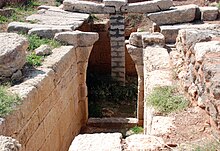Ras Ibn Hani
رأس ابن هاني Template:Ar icon | |
 A tomb at Ras Ibn Hani | |
| Alternative name | Betyllion |
|---|---|
| Location | Latakia, Syria |
| Type | Settlement |
| Area | 2 ha (4.9 acres) |
| History | |
| Periods | Late Bronze Age to Early Byzantine |
| Cultures | Canaanite, Hellenistic, Roman |
| Satellite of | Ugarit |
| Site notes | |
| Ownership | Mixed public and private |
| Public access | Partial |
| Now is the site of Cote d'Azur | |
| Ugarit |
|---|
 |
| Places |
| Kings |
| Culture |
| Texts |
Ras Ibn Hani (Arabic: رأس ابن هاني) is a small cape located 8 kilometers (5.0 mi) north of Latakia, Syria on the Mediterranean Sea. It is an important archaeological site as it was occupied almost continuously from the late Bronze Age until Byzantine times.[1] The site now is in a major resort area called the Cote d'Azur of Syria.[1]
History
This coastal site lies a two-hour walk from the site of Bronze Age Ugarit, and survived in modest fashion Ugarit's collapse at the end of the Bronze Age: "Ugarit's inhabitants dispersed, but no crisis could neutralize their invaluable asset, the coast's best natural harbour on the promontory of Ras ibn Hani; it became known from its low white cliff as the 'White Harbour' in later Greek coastal guidebooks, a name which persists in modern Arabic as Minet el-Beida", observes Robin Lane Fox,[2] who identified Ras Ibn Hani as the site later Greeks knew as Betyllion,[3] possibly a Hellenized version, he suggests, of the Semitic bait-El or "house of El, a name which, if that is the derivation, "confirms that Canaanite-Phoenician culture never entirely died at the site".
Robin Lane Fox notes[2] that Trajan landed at this spot to join his troops in Syria for the fateful Mesopotamian campaigns of 114–117 CE.
See also
References
- ^ a b Cohen, 2006, p. 124
- ^ a b Fox, Travelling Heroes in the Epic Age of Homer, 2008:91.
- ^ Fox gives his source as John Malalas,'s Chronicon (11.3) written in the 6th century CE, which has the form Bytyllion, which is also the form reported in Barrington Atlas of the Greek and Roman World (Princeton) 2000.
Bibliography
- Cohen, Getzel M. (2006). The Hellenistic settlements in Syria, the Red Sea Basin, and North Africa. University of California Press. ISBN 978-0-520-24148-0.

